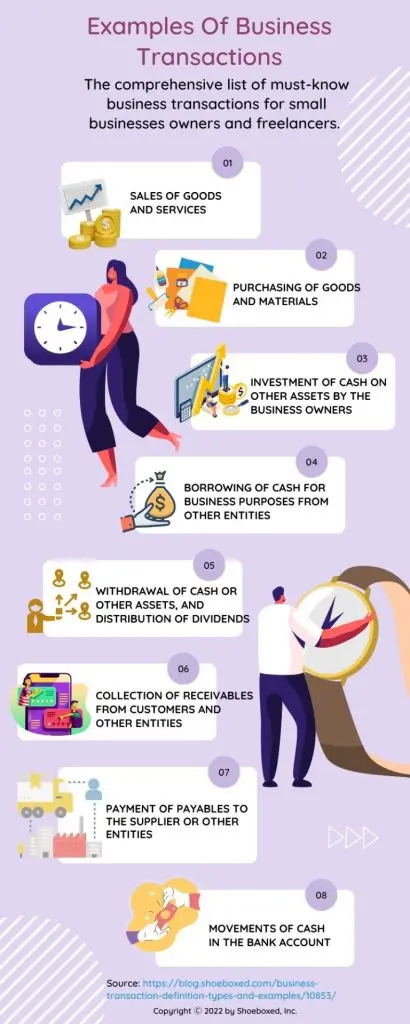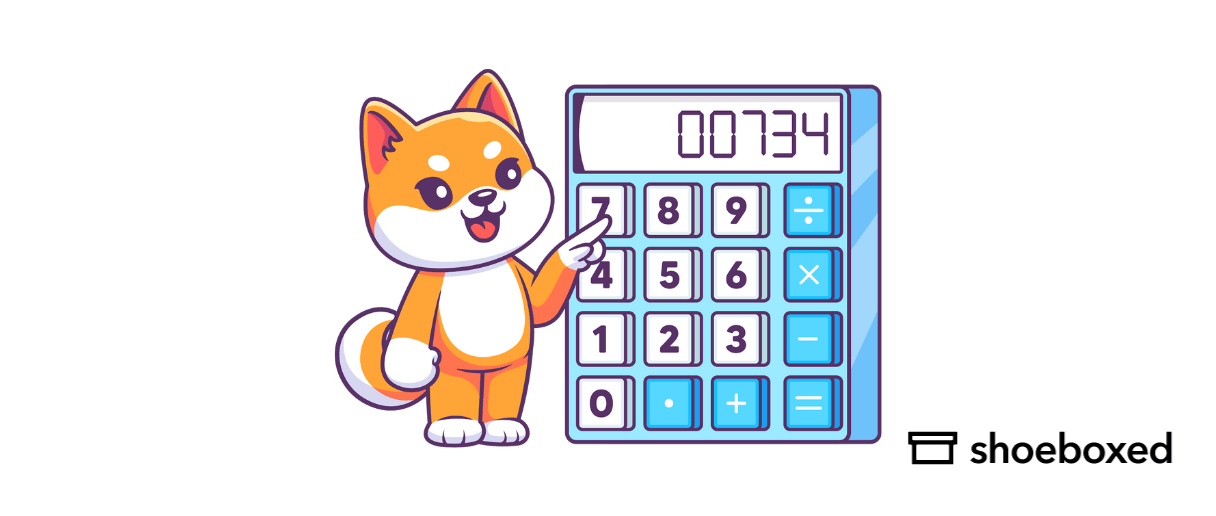Business transactions are a crucial aspect of every business. Without it, a business may not know its position at a particular period. This business transaction guide will give a business transaction definition, its different types, and examples of typical business transactions.
The business transaction definition
In accounting, a business transaction is an event that takes place between two companies and affects their financial position. It can also be any economic activity that occurs in a business. All business transactions must have a document to prove they happened.
According to Accounting Tools, a professional site providing accounting CPE courses and resources, the following items are good examples of business transactions:
Buying insurance from an insurer
Buying inventory from a supplier
Selling goods to a customer for cash
Selling goods to a customer on credit
Paying wages to employees
Obtaining a loan from a lender
Selling shares to an investor
A bookkeeper or accountant must record each business transaction in a journal entry. The documentation will help keep track of the business finances. The accountant or bookkeeper must ensure that the person responsible for a transaction has authorized it.
See also: Bookkeeping Job Description 101: Everything You Ought to Know
There must be a number of records that support a valid business transaction before being recorded in the journal. Typical source documents are bills of exchange, purchase invoices, promissory notes, payment vouchers, sales invoices, cash receipts, statements of accounts, and even digital or e-receipts.
If you have any other documents related to your purchase, like your receipt or packing slip, these can be used as proof that the transaction was valid.
See also: What Is A Transaction Receipt? Meaning, Examples, How-tos
Characteristics of a business transaction
A business transaction can be an exchange transaction that involves a physical value exchange like a purchase or a non-exchange transaction that does not involve a physical exchange like an internal production. A transaction in business can involve just exchanging money, or it can involve a longer-term agreement. However, a business transaction needs to cover these characteristics:
The transaction is for a certain amount of money.
The transaction happens between two parties.
The transaction is for the benefit of the business, not an individual’s personal use.
The transaction has proper documentation, such as an invoice, receipt, or voucher to record it.
The transaction has a two-fold effect on the balance sheet. In other words, a minimum of two items must be present for each transaction, such as assets, liabilities, or owner’s equity.
See also: The Ultimate Receipt Organization & Management Resource
The Two-Fold Effect of AccountingMain types of business transactions
Cash and credit transactions
There are two ways to categorize business transactions: cash-based and credit-based. The former refers to transactions where money exchanges hands, while the latter refers to transactions where credit is given or borrowed.
1. Cash transaction
In a cash transaction, the payment was paid or received in cash when the transaction occurred.
In today’s business world, people can make and receive payments in many ways other than using currency notes. All debit and credit transactions are also classified as cash transactions.
2. Credit transaction
A credit transaction is made after a certain period, also known as the credit period. A party involved can receive the payment or pay it at a later time.
See also: The Small Business Accounting Checklist for 2022 [Infographic]
Internal and external transactions
1. Internal transaction
When no external party is involved in a business transaction, it’s classified as an internal transaction. There is no value exchange with a third party, but a financial event impacts the business’s balance sheet. An internal transaction can take the form of fixed asset depreciation or asset losses. The internal transaction is also known as a non-exchange transaction.
2. External transaction
An external transaction is a transaction between two parties who are not directly involved in each other’s businesses. Usually, a large portion of business transactions consists of external transactions.
10 examples of business transactions
Let’s take a look at some common business transactions:
Sales of goods and services, either for cash or credit.
Purchasing of goods and materials, either in cash or credit.
Purchasing services such as delivering service or marketing services.
The business owners are investing their cash in other assets.
Borrowing money to finance your business.
A business owner withdraws their cash or other assets from the company, then distributes the dividends to the shareholders.
Employers pay their employees’ wages and salaries.
The business reimburses tax and accounting services.
Your business collects money from customers and other entities.
When you pay someone else, you send them money to pay for what they have already bought.
Additionally, depreciation or expiration of assets such as office supplies usage, insurance expiration, lease expiration, or equipment depreciation.
Movements of cash in one’s bank account usually arise from the transactions above.
Examples of non-business transactions
As we’ve mentioned above, a business transaction must satisfy certain criteria to be a business transaction. It’s good to keep in mind that not all transactions are business-related.
In other words, a non-commercial transaction is one that a company makes that does not involve buying or selling, such as donations or fulfilling social responsibilities.
The definition of “non-business transaction” also depends on the transaction’s context.
When it comes to accounting, non-financial transactions are those in which equity, expenses, liabilities, and income remain unchanged. For instance, selecting an employee for a managerial role is a non-financial transaction. There is no need to make a journal entry for such an occasion.
In the context of customer and business transactions, sending quotations for sales to a buyer is a non-business transaction as this does not lead to the creation of any agreements between the parties, and no assets or liabilities are involved.
In the context of corporate social responsibility, philanthropic efforts, such as charity events or donations that do not affect the assets and liabilities of the organization are non-business transactions.
Never lose a receipt again 📁
Join over 1 million businesses scanning receipts, creating expense reports, and reclaiming multiple hours every week—with Shoeboxed.✨
Get Started TodayHow should one record business transactions?
Business transactions are daily activities that help maintain business operations. The accounting cycle system affects various factors, such as assets, liabilities, capital, income, and expenses. These can be divided into two categories: those that can be exchanged and those that cannot be.
Exchange transaction
This is the process of exchanging goods between two parties, in which one party accepts assets and the other party accepts a similar value in payment.
Non-exchange transaction
The business received value from another party (the customer) without giving anything in return. This refers to the wear and tear on equipment, fines and penalties, donations, and the like due to natural disaster events or company regulations.
Methods to record a business transaction
There are four different ways to record your business transactions.
Method 1. Recording transactions in a system.
Recording transactions is the most common way to keep track of business transactions. Generally, you need to input all transactional data for each transaction in a system, such as a book or a journal. Accountants and bookkeepers may know of a method called “journal entry” which can be helpful in tracking finances. Many companies use digital versions of journals or ledgers to streamline their accounting process.
See also: Virtual Bookkeeping Jobs: The Total Guide
Method 2. Generating an invoice.
Using accounting software, you can systematically generate an invoice for a customer with the data input in your journal entry system. You must provide information about the product or service you sold, such as the price, quantity, and applicable sales tax. After you deliver the invoice to your customers, the information will go to your company’s receivable account.
Method 3. Obtaining invoices from another company or business.
When another company or business sends you an invoice, remember to document this information in a payable or accrued expense account. Maintain copies of both invoices for your records.
Method 4. Tracking paychecks’ records.
Keeping track of employees’ paychecks is crucial because it can be a substantial expense. Ensure to input your employees’ pay rates, hours worked, and payroll account deductions in your accounting system.
See also: How to Use Quickbooks Online Accountant: Steps, Tips, and More!
Turn receipts into data with Shoeboxed ✨
Try a systematic approach to receipt categories for tax time. Try free for 30 days!
Get Started TodayFrequently asked questions about business transactions
What is a personal transaction? And what are some examples of a personal transaction?
Personal transactions occur when employees or businesses spend money for personal reasons. Some companies require employees to pay for transactions, while others offer a set amount for personal use.
What are some examples of internal transactions?
Business transactions can be broken down into cash and credit transactions or internal and external transactions. Internal transactions happen between people who are closely related or who are part of the same organization. Internal transactions happen all the time within businesses. For example, a business might record depreciation on a fixed asset, a loss due to fire, or provide services to another business unit.
Which of the following events represent business transactions?
a. Machinery is purchased for cash
b. Goods are ordered for delivery next month
c. The owner of the firm dies
d. An employee is dismissed from his job
The correct option is A – Machinery is purchased for cash. All of the above events affect the business, but only purchasing machinery for cash changes the accounts balances. Therefore, it is a business transaction that shall be recorded in the books.
Which of the following events is not a business transaction recorded in financial accounting?
A. Purchasing a service
B. Paying wages
C. Receiving goods
D. Signing an agreement with a supplier
The correct option is D – Signing an agreement with a supplier.
Bonus infographic: Examples of business transactions

Examples of business transactions.
Final thoughts
It’s important to understand your company’s role in a transaction. It affects everything from customer services to marketing, pricing, and more. Thoroughly understanding these types of business transactions helps you make more informed decisions about the business.
In most cases, companies have to work with multiple types of business transactions, and they need to keep track of them with various types of paperwork like invoices, receipts, and expense reports. If this sounds familiar to you, consider digitizing your paper receipts and organizing them.
To hone your bookkeeping skills and learn more bookkeeping terms so you can accurately monitor the financial health of your company, check out our mammoth list of 45+ bookkeeping resources!
About Shoeboxed!
Shoeboxed is a receipt scanning service with receipt management software that supports multiple methods for receipt capture: send, scan, upload, forward, and more!
You can stuff your receipts into one of our Magic Envelopes (prepaid postage within the US). Use our receipt tracker + receipt scanner app (iPhone, iPad and Android) to snap a picture while on the go. Auto-import receipts from Gmail. Or forward a receipt to your designated Shoeboxed email address.
Turn your receipts into data and deductibles with our expense reports that include IRS-accepted receipt images.
Join over 1 million businesses scanning & organizing receipts, creating expense reports and more—with Shoeboxed.
Try Shoeboxed today!



